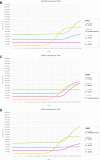Evaluation of the Performance of a Multiplex Real-Time PCR Assay for the Identification of Aspergillus, Cryptococcus neoformans, and Pneumocystis jirovecii Simultaneously from Sputum in Multicenter
- PMID: 36267265
- PMCID: PMC9576602
- DOI: 10.2147/IDR.S379043
Evaluation of the Performance of a Multiplex Real-Time PCR Assay for the Identification of Aspergillus, Cryptococcus neoformans, and Pneumocystis jirovecii Simultaneously from Sputum in Multicenter
Abstract
Purpose: To evaluate the performance of a multiplex real-time polymerase chain reaction (PCR) assay for the simultaneous identification of Aspergillus, Cryptococcus neoformans, and Pneumocystis jirovecii from sputum.
Patients and methods: Sputum samples (n=537) from patients with suspected invasive fungal infection (IFI) were collected from four centers; they were tested by both multiplex real-time PCR assay and DNA sequencing. DNA sequencing was considered as the reference method, and the performance of the multiplex real-time assay was evaluated by determining the sensitivity, specificity, positive predictive value (PPV), and negative predictive value (NPV). The interference experiment, repeatability, reproducibility, and stability of the multiplex real-time PCR assay were also evaluated.
Results: The detection performance of the multiplex real-time assay, compared with that of DNA sequencing, for the three pathogens was as follows: sensitivity, specificity, PPV, and NPV for Aspergillus, Cryptococcus neoformans, and Pneumocystis jirovecii were 99.40%, 98.64%, 97.09%, and 99.73%; 100%, 99.59%, 96.36%, and 100.00%; and 99.28%, 98.50%, 95.80%, and 99.75%, respectively. The consistency of the two methods was almost perfect: the kappa value was between 0.97 and 0.98. The minimum detection limit of the multiplex real-time assay for each of the three pathogens was 1250 copies/mL. Interference experiment showed that blood and normally used antifungal drugs had no effect on the results. No cross-reactivity was detected for any bacteria or fungi. In 40 patients, mixed infections by Aspergillus and/or Cryptococcus neoformans and/or Pneumocystis jirovecii were detected by the multiplex real-time assay. Among these patients, those with acquired immune deficiency syndrome (AIDS) ranked first, with Aspergillus and Pneumocystis mixed infection accounting for 75%.
Conclusion: The multiplex real-time PCR assay is fast, sensitive, and specific and has good clinical application prospects.
Keywords: Aspergillus; Cryptococcus neoformans; Pneumocystis jirovecii; invasive fungal infection; multiplex real-time PCR; sequencing.
© 2022 Liu et al.
Conflict of interest statement
The authors report no conflicts of interest in relation to this study.
Figures


Similar articles
-
Evaluation of the Performance of a Multiplex Real-Time PCR Assay for the Identification of Aspergillus, Cryptococcus neoformans, and Pneumocystis jirovecii Simultaneously from Sputum in Multicenter [Letter].Infect Drug Resist. 2022 Nov 24;15:6799-6800. doi: 10.2147/IDR.S396184. eCollection 2022. Infect Drug Resist. 2022. PMID: 36451899 Free PMC article. No abstract available.
-
A multiplex real-time PCR assay for identification of Pneumocystis jirovecii, Histoplasma capsulatum, and Cryptococcus neoformans/Cryptococcus gattii in samples from AIDS patients with opportunistic pneumonia.J Clin Microbiol. 2014 Apr;52(4):1168-76. doi: 10.1128/JCM.02895-13. Epub 2014 Jan 29. J Clin Microbiol. 2014. PMID: 24478409 Free PMC article.
-
Evaluation of the Performance of a Multiplex Real-Time PCR Assay for the Identification of Aspergillus, Cryptococcus neoformans, and Pneumocystis jirovecii Simultaneously from Sputum in Multicenter [Response to Letter].Infect Drug Resist. 2022 Dec 23;15:7651-7652. doi: 10.2147/IDR.S400931. eCollection 2022. Infect Drug Resist. 2022. PMID: 36582455 Free PMC article. No abstract available.
-
A New Age in Molecular Diagnostics for Invasive Fungal Disease: Are We Ready?Front Microbiol. 2020 Jan 14;10:2903. doi: 10.3389/fmicb.2019.02903. eCollection 2019. Front Microbiol. 2020. PMID: 31993022 Free PMC article. Review.
-
Molecular diagnosis and epidemiology of fungal infections.Med Mycol. 1998;36 Suppl 1:249-57. Med Mycol. 1998. PMID: 9988514 Review.
Cited by
-
Fungal Spectrum and Susceptibility Against Nine Antifungal Agents in 525 Deep Fungal Infected Cases.Infect Drug Resist. 2023 Jul 18;16:4687-4696. doi: 10.2147/IDR.S403863. eCollection 2023. Infect Drug Resist. 2023. PMID: 37484904 Free PMC article.
-
Evaluation of the Performance of a Multiplex Real-Time PCR Assay for the Identification of Aspergillus, Cryptococcus neoformans, and Pneumocystis jirovecii Simultaneously from Sputum in Multicenter [Letter].Infect Drug Resist. 2022 Nov 24;15:6799-6800. doi: 10.2147/IDR.S396184. eCollection 2022. Infect Drug Resist. 2022. PMID: 36451899 Free PMC article. No abstract available.
-
Diagnostic value of metagenomic next-generation sequencing of lower respiratory tract specimen for the diagnosis of suspected Pneumocystis jirovecii pneumonia.Ann Med. 2023 Dec;55(1):2232358. doi: 10.1080/07853890.2023.2232358. Ann Med. 2023. PMID: 37403381 Free PMC article.
-
Development of a Multiplex Real-Time PCR Assay for the Simultaneous Detection of Two Fungal Pathogens Causing Pneumonia.J Fungi (Basel). 2024 Aug 29;10(9):619. doi: 10.3390/jof10090619. J Fungi (Basel). 2024. PMID: 39330379 Free PMC article.
-
Incongruence between confirmed and suspected clinical cases of Japanese encephalitis virus infection.Front Cell Infect Microbiol. 2024 Jan 26;14:1302314. doi: 10.3389/fcimb.2024.1302314. eCollection 2024. Front Cell Infect Microbiol. 2024. PMID: 38343888 Free PMC article.
References
-
- Donnelly JP, Chen SC, Kauffman CA, et al. Revision and update of the consensus definitions of invasive fungal disease from the European Organization for Research and Treatment of Cancer and the Mycoses Study Group Education and Research Consortium. Clin Infect Dis. 2020;71(6):1367–1376. doi:10.1093/cid/ciz1008 - DOI - PMC - PubMed
-
- Gago S, Esteban C, Valero C, et al. A multiplex real-time PCR assay for identification of Pneumocystis jirovecii, Histoplasma capsulatum, and Cryptococcus neoformans/Cryptococcus gattii in samples from AIDS patients with opportunistic pneumonia. J Clin Microbiol. 2014;52:1168–1176. doi:10.1128/jcm.02895-13 - DOI - PMC - PubMed
LinkOut - more resources
Full Text Sources
Other Literature Sources

